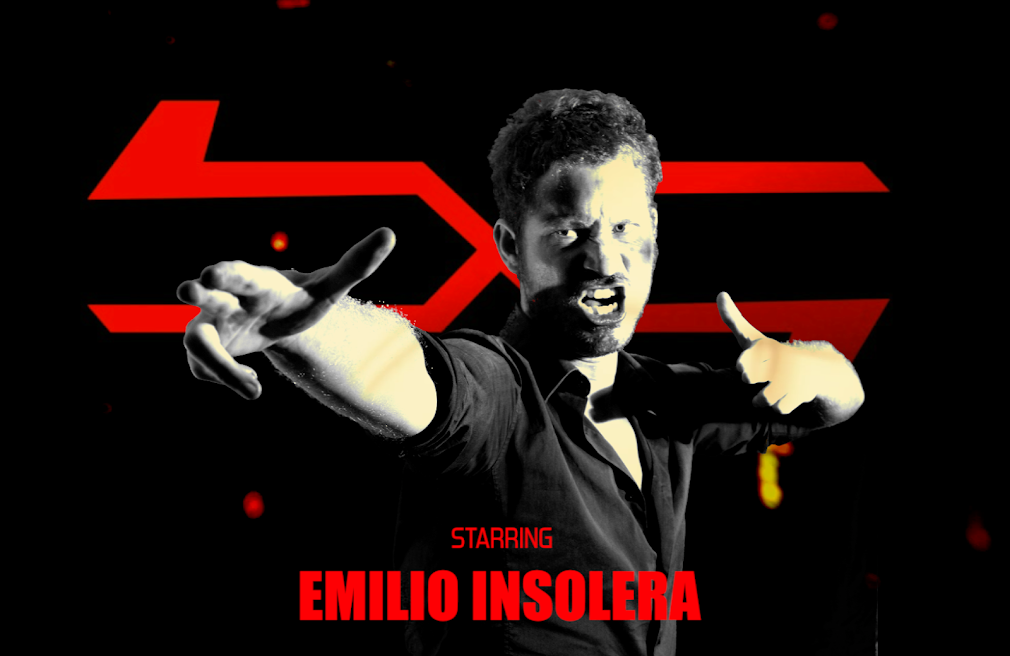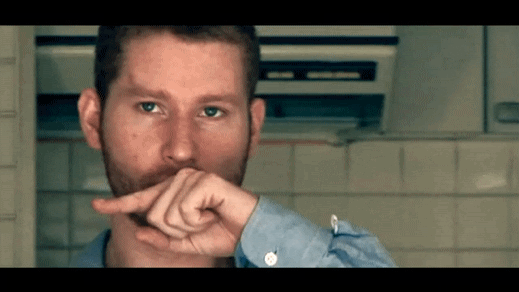WHEN SIGN LANGUAGE IS A SUPERPOWER
Emilio Insolera's new film uses the underground history of sign language as the premise for a superhero thriller.
By Coby Mc Donald. April 10, 2018
When Emilio Insolera was a teenager growing up in Italy, he knew he wanted to be a filmmaker. And he had the pedigree: His grandmother was an actor who ran in the same circles as famed director Federico Fellini. But when Insolera admitted his dream to his grandmother, he didn't get the response he'd hoped for.
"She was very blunt with me," he says. "She told me, it's impossible. You can't do it. Because you're deaf."
In the end, he didn't listen.
On April 13th, Insolera's first feature film, Sign Gene, will make its United States debut at the Laemmle Theater on Wilshire Boulevard in Los Angeles. The plot centers on an international band of deaf people, who, thanks to a genetic mutation, can channel superpowers through their use of sign language. The independent film is a fast-paced, genre-bending romp, shot on three continents with a cast made up entirely of deaf actors and CODAs (meaning children of deaf adults). Insolera has created the movie for both deaf and hearing audiences, and says he hopes that hearing audiences will come away from it with a broadened understanding of the richness of deaf language and experience.
"Deaf people are living great lives, fun lives, creative lives," Insolera tells me through an interpreter. He wants to challenge the common film portrayal of deaf people as isolated, dependent, and even pitiable. "It's an antiquated trope, and it's boring to me. It's not inspiring whatsoever."
The premise of Sign Gene, that sign language is a source of power, has deep resonance for the deaf community. For much of the 19th and 20th centuries, sign language was denigrated as a primitive form of communication used, as Charles Darwin once wrote, "by the deaf and dumb and by savages." Sign language was banned in most deaf schools in the U.S. and Europe in the early 1900s because many deaf educators (nearly all of them hearing) believed that sign was an impediment to deaf people's assimilation. Prominent eugenicists, including Alexander Graham Bell, warned that sign language led to deaf intermarriage, which could cause the formation of a deaf race. Sign language was driven underground, where it remained the often-covert language of the deaf community, linking them to each other and to a shared set of cultural and linguistic touchstones.
Things changed in the 1960s when renowned linguist William Stokoe pioneered the field of sign language linguistics. He mapped the grammatical structure of American Sign Language (a first for a visual language), confirming what deaf people had known all along: Sign languages aren't just pantomimes, but rather full, unique languages with a grammatical complexity equal to that of spoken ones. Stokoe's work also helped chip away at the myth that ASL is just English rendered with the hands. In fact, ASL developed largely independent of English linguistic influence, and employs distinct grammar and syntax. As the disability rights movement gained steam in the 1970s, bans on using sign language in schools were lifted, and there was an explosion of deaf arts and culture—and also of deaf pride.
"Typically deafness is defined by loss: hearing loss," says H.-Dirksen Bauman, chair of the American Sign Language and Deaf Studies Department at Gallaudet University in Washington, D.C., known as the premiere university in the world for the deaf. "But deaf people's lives aren't really defined by that sense of loss. Quite the opposite: There's this feeling of plentitude, that there's something unique and valuable. So there's this idea that someone can lose their hearing but gain their deafness."
As an undergraduate at Gallaudet, Insolera found himself immersed in deaf culture. He studied linguistics, deaf studies, and his childhood passion, film.
"For the first time, I got an academic understanding of the culture and language I grew up in," he says. "And I wanted to take that understanding and convert it into entertainment for the masses."
While in school, Insolera conceived of the idea of deaf superheroes who derived powers from sign language. The idea was rooted in research showing that sign language can actually boost certain mental functions, such as facial recognition and processing spatial information.
"Of course the film is a bit fantastical," Bauman says, "but sign language does have power in a very literal cognitive sense."
Insolera began work on Sign Gene in 2009, scraping together funds for a shooting schedule that would span the U.S., Italy, and Japan. Making a film for both deaf and hearing audiences would be tricky. Though most of the film's dialogue is in sign languages (American, Italian, and Japanese), there are a few scenes with spoken lines. Insolera recalls one shoot where the spoken dialogue caused a brief misunderstanding.
"I said: 'OK cut. That's a wrap. That was great.' Suddenly everyone was laughing because apparently the actor had said his lines totally wrong," Insolera says. (He hadn't been watching the actor's lips). "Oh man, I was embarrassed! But I was like, 'OK, let's do another take.'"
Another challenge was deciding just how much background in deaf culture to include so that hearing viewers wouldn't get confused.
"These are stories that are familiar to deaf people," Insolera says. He wanted to bring hearing people up to speed, "but I didn't want deaf audiences to lose interest. It was about finding that balance."
The movie begins with a mysterious murder. A deaf woman, the daughter of a U.S. senator, turns up dead in Japan, her injuries suggesting a supernatural cause. The U.S. government enlists two agents from the Q.I.A. (a secret government agency comprised of carriers of the sign-gene mutation) to head to Japan and crack the case. Agent Tom Clerc, played by Insolera, and his partner Ken Wong suspect the involvement of an evil organization called 1.8.8.0., which is intent on cleansing the world of the sign-gene mutants.
Sign Gene is replete with coded references to a history and culture that most hearing people know nothing about. Q.I.A. stands for QuinPar Intelligence Agency, and QuinPar refers to the five phonological components in sign language linguistics that form signs: handshape, movement, location, orientation, and non-manual signals. Agent Tom Clerc shares the surname of a famous figure in deaf history, Laurent Clerc, a deaf educator who brought sign language to the U.S. And 1.8.8.0. is a reference to the Second International Congress on Deaf Education, which took place in Milan, Italy, in 1880. It was there that educators codified their recommendation to eliminate sign language from deaf education.
Hearing viewers of Sign Gene are likely to feel like they're being dropped into the deep end of the pool. But Insolera—who writes, directs, and stars in the film—is OK with that. He hopes the experience of auditory and visual disorientation will give hearing people a window into the deaf experience.
"A deaf child experiences technology like hearing aids or cochlear implants, and often you hear these strange, unnatural sounds. It can be really annoying or even disturbing," he says. "I decided to include some of that experience in the movie."
Sign Gene is playful and stylistically experimental—if at times a bit jarring (it comes with a warning for viewers with epilepsy). The film includes breathless, sign-language-fueled fight scenes that draw from martial arts flicks, alongside a gritty futurism that brings to mind sci-fi classics like Blade Runner. Insolera made Sign Gene on a mere $25,000, and the slender budget sometimes shows. It's a bit rough around the edges, but often delightfully so. And Insolera hopes to interest Hollywood in a more polished version
The film industry has been especially risk-averse in recent years, but with the recent success of films like the Black Panther and the Oscar-winning short The Silent Child, Insolera sees a window for a new kind of film to break through.
"I hope I can inspire more diversity in projects that are out there," he says. "And at the same time, I hope it inspires people in the industry to experiment more and invest more in these types of productions."
His timing may be just right. Deafness appears to be enjoying a surge in pop-culture representation. Three films nominated in this year's Oscars included characters who use sign language. The sketch comedy show Portlandia recently aired a sketch that was entirely in ASL. And deaf model and sign language advocate Nyle DiMarco won first prize in America's Next Top Model and Dancing With the Stars in 2015 and 2016 respectively.
"One of the greater indicators of a healthy social ecosystem," Bauman says, "is a diversity of perspectives and ideas and experiences and bodies."
Sign Gene certainly provides that diversity. It would be hard to come away from the film without feeling like you'd seen something entirely new.



































